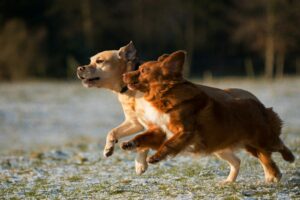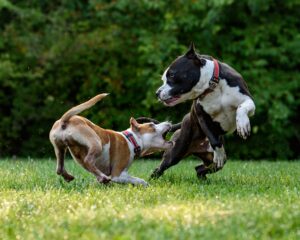Menu
How to Introduce a Second Dog
Some dog owners experience introducing two new dogs as a fun and easy process. However, it can be challenging if one or both dogs are either reactive or nervous with new dogs. How to introduce a second dog when you’re concerned about their behavior requires careful planning and patience. You may be introducing your dog to a friend or family member’s dog or bringing home a new dog. In either case, these tips will be helpful for that initial introduction.
The best goal is to have the dogs achieve a level of calmness before they interact face to face. Arousal is a term to describe a state of over-excitement in dogs. All types of dogs can be in a state of high arousal including a happy-go-lucky goofball to a leash reactive dog lunging and barking at the end of the leash. It simply means there is a lot of energy in their system. It’s best to make sure dogs are in a calm state of mind before greeting. If you’re worried about the safety of the dogs meeting for the first time, make sure they have calmed down.
Two Recommended Ways for How to Introduce a Second Dog
Pack Walks
Pack walks are a great way to introduce new dogs. This is because dogs are descendants from wolves that operate in packs hunting or journeying together. They are socially inclined animals that can bond over the shared experience of walking even if they do not directly greet on a walk.
Tips for Dog Pack Walks
- Do not let dogs sniff on-leash.
- Humans can be in the center if you are walking side by side to create a barrier for the dogs. You can also walk behind one another.
- If both dogs are doing well, you can gradually allow the dogs to sniff each other’s butts for a few seconds at a time. Then pull them away and keep walking. Let them get in some brief sniffs but redirect them back into the walk to avoid any escalation. Remember that on-leash greetings generally do not go well, so only let them sniff for a second then keep moving.
Chilling in One Spot on Leashes
Both dog handlers go to a neutral location like a park or café, and just hang out until the dogs get calm and more disinterested in each other. It’s not necessary to let the dogs meet, in fact, on-leash greetings often do not go well. I’d recommend doing this for one or more sessions of at least 30 minutes.
It’s actually best to try to relax as you are doing this. Talk to the other human you are with about things other than the dogs. Dogs are empathic and pick up on our energy. Get the focus off of them in order to relax more about the situation.
You may try pack walks or chilling in one spot, or both! Doing either of these activities with two handlers can help the dogs to build trust and observe each other’s body language and behavior.
Here are 10 Tips for How to Introduce a Second Dog
Do Not Let Strange Dogs or People Approach Your Dog
If you have a nervous or reactive dog, in general, be careful about who you let your dog meet. Our cultural image of a happy go lucky dog that loves meeting everyone, can get a lot of folks into trouble. Certain types of dogs do not really enjoy meeting strange people or dogs. In addition, many people feel they “need more socialization,” so they force them to into these encounters (especially with treats). This can actually create negative associations and work against you. Be selective.
Proper socialization is more about being around dogs, people, busy city streets, cars etc. If a dog can exist around these things in a calm state of mind, they are being socialized.
2. Introduce New Dogs in a Neutral Territory
Often dogs that struggle with meeting other dogs will be even more challenged if they are meeting at their own homes. If you are wondering how to safely introduce new dogs, go to a place that both dogs are unfamiliar with. This will help to eliminate any territorial behavior and potential resource guarding of furniture, bowls, toys, chews etc. If the meeting will be at someone’s home, remove all objects that could potentially be guarded.
3. Peaceful Co-existence is Key
This is a concept many dog trainers talk about. The goal shouldn’t be to expect too much too soon. Challenging dogs need to either do pack walks or hang out around each other (with leashes on) for a period of time without greeting. In addition, they may need several sessions of this before you feel comfortable letting them off-leash to meet.
4. Don’t Introduce New Dogs on a Leash
Often on-leash greetings do not go well. This is because the leash creates a feeling of tension and restriction in dogs because they cannot move freely. This leads them to mis-interpreting each other’s body language and potentially growling at each other or getting into a scuffle. The leash can lead to frustration for many dogs. In addition, sometimes owners are nervous about the introduction to a new dog, which dogs can in turn sense. This can add fuel to the fire.
5. Do Not Introduce New Dogs at Dog Parks
If you are struggling with how to introduce a second dog, skip going to the dog park. Go to a calmer park or outdoor area with less going on and just have your dog observe. This will help to foster a calmer state of mind in both dogs.
6. Understanding Dog Body Language and Triggers
If you have a reactive dog or a dog that is uncomfortable around new dogs, pay close attention to signs of growing, showing teeth, continual barking, and defensive body language. Intense staring for reactive dogs is a big warning sign and the term is called, “loading.” It means the dog is far from having achieved a neutral state of mind in relation to the other dog.
Dog reactivity is when a dog shows displays of lunging, barking and growling towards other dogs while on a leash. If you are struggling with dog reactivity, a well timed correction or redirection can help the process. However, working with a professional balanced dog trainer that specializes in addressing dog reactivity is ideal if you feel like you’re in over your head.
You may also see signs of avoidance in your dog. This is a nervous dog that may crouch behind you or use you as a barrier to the other dog. Make sure you give them enough space to feel secure and safe. Doing a pack walk and then going to a park or quiet school field and sitting 10 – 15 feet away from each other for 30 minutes may be best in these cases.
7. Try Skipping Treats for New Dog Introductions
If you are wondering how to safely introduce new dogs, treats may or may not be helpful. Sometimes treats can complicate things by amping dogs up into a state of high arousal, which is what you want to avoid. Like I said, you may need to do several sessions of being together without greeting face to face to make it a positive association.
Wondering how to introduce your dog to a cat, my other blog on that might help. 
8. Do Not Pet Any Dog Showing Signs of Reactivity or Nervousness
It’s best to be neutral and utilize more distance between each other if you are seeing those signs. Movement of the dogs is always good in these cases, which is why walking is recommended. It helps to break the dogs out of these problematic states of mind. Pet a nervous or reactive dog will only reinforce those behaviors more.
9. Teach Your Dog a Strong Recall
A strong e-collar off leash re-call command (“come” command), is really good for reactive dogs in general. It helps break the mental patterns of fixation on the other dogs. It’s also good to know that if and when you actually do let them off leash to say hi to the other dog, you could call them back if needed.
10. The Last Phase of Letting the Dogs Finally Sniff and Interact
When you finally decide to let the dogs off leash to interact, let them drag their leashes so that you can pick them up if it gets out of control too quickly. Always have 2 or more people to assist you. Have a tool like the Pet Corrector (compressed air for reactive pets) if you need to correct both dogs and deescalate things quickly.
If the dogs have a strong re-call you can interupt their initial meet and greet by calling them back to you, but be careful about having food around if they resource guard.
If it gets too amped up too quickly, get control by separating them and making them chill again for a period of time. It may take several sessions to make progress but keep at it.
Remember, if you have dogs that play too rough which can lead to fighting, don’t let them play for more than a few seconds at at time. Keep separating them. Humans must always have control in these situations. Do not believe the advice “dogs need to work it out.” It can get you into trouble. As the human, you call the shots.
Hopefully this advice reaches people and helps with the topic of how to introduce a second dog and how to safely introduce dogs.

